The Beautiful Kiswa or the Ghilaf of kaaba
Everytime I go for Umrah,I always wonder about the drape of kaab’a-the House of Allah.How beautiful is the calligraphy! I always wanted to stand there forever looking at the kiswa,and reading the ayats. I wanted to know which ayats are written in it?
Aso read : Abdul Wahab Al Shaibi becomes the new key-bearer of Holy Kaaba.
I wondered that such a beautiful intricate design must have some secrets,and then I began my research.I was astonished to know that it takes 20,million SR to produce the drape of kaaba. The beauty of Islam is that such a precious piece is not kept locked anywhere but distributed as a gift among the general public and to muslim countries. Masha Allah!
About the kiswa of kaaba
Kiswa ( kiswat al-ka’bah) is the cloth that covers the Kaaba in Mecca, Saudi Arabia.The holy Kaaba is covered with new kiswa (cover) every year on the 10th Dhu Al Hijjah, which coincides with Haj. It was a custom started by the Prophet Ismail (Pubh) 4000 years before the origin of Islam.The term kiswah is Arabic for ‘pall’, the cloth draped over a casket.
COST OF MAKING KISWAH
The present cost of making the kiswa amounts to 5.8 Million dollars. . The cover is 658m2 and is made of 700 kg of silk. The embroidery contains 120 kg of gold and silver threads. It consists of 47 pieces of cloth and each piece is 14m long and 101 cm wide. The kiswa is wrapped around the Kaaba and fixed to its base with copper rings. The manually designed embroidery of the Quranic verses are slowly being aided by computers, thus increasing the speed of production
DIMENSION OF KISWA
- According to Dr. Mohammed Bajouda, the manger of the Kiswah factory the Kiswah consists of 47 reels of cloth, each of which are 14 meters [46 feet] in length and 95 centimeters [3 feet] wide.
- On the top third of the cloth, there is the Kiswa belt which is 95 centimeters wide and 45 meters long.
- It consists of 16 pieces and surrounds the Kiswa from all sides.
- The belt is embroidered with protruding designs that are enameled with silver threads covered with gold. The material is made up of silk and a gold embroidered band is sewn about three fourth the distance from the bottom.
- The part covering the door, which stands 2.13 mts above the ground on the north-east side wall, is covered separately with richly embroidered Quranic verses, leaving an opening for the black stone
WHAT IS WRITTEN IN KISWA

CALLIGRAPHY:- Quranic verses are written on it in Ath-Thuluth style of Arabic calligraphy.
What is kiswa made of?
1)The Kiswa is made of pure natural silk dyed in black. On this silk are engraved the phrases:
” 0′ Allah, There is no God but Allah, Muhammad is the Messenger of Allah. The Most Loving, the Bene- factor. Glory be to Allah and Praise be to Allah and Glory is to Allah the Great”.
2)Under the belt, at each corner of the Ka’aba, Surah of Ikhlas (Purity of Faith) is written inside a circle surrounded by a square shape of Islamic embellishment
3)At the same height, also under the belt, there are six verses of the Holy Quran. Each of these verses is written in a separate frame.
4)On the areas separating these frames there is a shape of a lamp on which either of the following Phrases is written:”O’ you The Alive The Self Subsisting”. “The Most Gracious, the Most Merciful”, or “Praise be to Allah”. All that is written under the belt is in Ath- Thuluth style of handwriting, embroidered in protruding designs and interwoven with silver threads covered with gold.
5) Earlier the Kiswas’ were plain. Only in 1340 the embroidery border tradition was introduced by the Egyptian ruler Hassan.
6)KISWA WAS NOT BLACK :The colour of Kiswa kept changing during the reigns of different Caliphs and rulers.Once the grand mother of Prophet Mohammed (Pbuh) had offered white Kiswa.The Caliph Al-Ma’mun, draped the Kaaba three times a year, each time with a different colour: red on the eighth of Dhu al-Hijjah, white gabati on the first of Rajab, and another red brocade on the twenty-ninth of Ramadan. Later on, Al-Nasir draped the Kaaba with green; both he and Al-Ma’mun disagreed on the frequent colour changes and switched to black, the only colour that has since been used for Kiswah.Nassir Abbasi (1160-1207) started green Kiswa and later shifted to black, since then the black kiswa has become the tradition.
MAKING OF KISWA
1)More than 200 men labor in a factory for eight months to produce the gold-embroidered, black-dyed Kiswa, a silk cover for the Kaaba
2)Today the 658-square-meter covering is made of 670 kg (1,500 lb) of high-quality silk imported from Italy and Switzerland,
3)The silk is dyed black and it is spun in soudi arabia to make the fine material, then it is hand-embroidered with 120 kg of pure gold and silver
The actual ‘kiswa’ is in three main parts: the Sitaar (curtain) of the Kaaba door, the inner-lining curtain inside the Kaaba and the ‘Hizam’ (the belt) of the Kaaba. All are made in an exclusive and specialized Kaaba Kiswa Factory where the most accurate and skillful levels of production are employed whether in the actual material from which the Kiswa is made or the embroidery that is used on it.
The Sitaar, 6.5 meters high and 3.5 meters wide is made of black silk with a thick green silk lining. Verses from the Qur’an are written on it and Islamic designs are prominently embroidered upon it and all are covered in silver wiring plated with gold.
The curtain lining the inside of the Kaaba is hand-woven and thus calls for accuracy and skill as well as genuine artistry. Its making consists of several phases beginning with dyeing the silk green. Verses and designs are drawn and printed onto the green silk for the embroidery that is to follow. Among the most delicate and longest processes is the embroidery, which is stitched in white over the intricate designs and printed verses. The green silk is then spread and draped over the inner walls of the Kaaba as well as on its ceiling. This part of the inner lining is changed every 3 to 5 years.
The third main part of the Kiswa is the ‘Hizam’ or the belt of the Kaaba. It is an exquisite work of art. Placed two-thirds of the way between the ground and the top of the Kaaba, the Hizam crowns the Kaaba with golden beauty and radiance. The ‘Hizam’ is a belt woven of verses and Islamic designs embroidered in thick silver wiring, densely coated in gold. It is 47 meters in length and 95 cm wide.
Because of the spiritual significance of the Kaaba, an official ‘kiswa’ factory was established during the reign of King Abdul Aziz in 1346H with Sheikh Abdul Rahman Muzhar as its first manager. The factory produced its first ‘kiswa’ that same year and the work was later expanded from three sections into a total of six.
Making the Kiswa is divided into five stages. First there is the dyeing phase which begins with the raw silk material soaked and bathed in hot water mixed for 24 hours with soap as well as other elements. The silk then turns a dazzling white and is then dyed black or green depending on which part of the Kiswa it is for. Any threads to be used for lining are also dyed in the appropriate color. Then there is the second stage which is weaving. Previously most of the weaving was done by hand; however, for the larger parts of the Kiswa which do not require great artistic delicacy, the weaving is done mechanically. Hand-weaving is still used for the final touches that can only be added by human artistic touch.
The next phase is the printing of all designs and calligraphy that will be placed on the ‘Hizam’ or on parts of the Kiswa which are embroidered. The fourth phase is the actual embroidery and it is the longest and most strenuous stage. All the designs and calligraphy are embroidered by hand in silver and gold wiring. The verses and designs are filled with cotton stuffing and then covered in cotton threads of yellow and white in adjacent positions. Then it is covered in golden silver wired embroidery which protrudes from the Kiswa up to 2 centimeters which is why this process cannot be mechanically done. The final phase is the preparation process for dressing the Kaaba, which involves coordinating and locating the corners of the Kiswa so that the proper designs and verses can be displayed in their specified places. Additional lining may be added to some areas.
History of Kiswa -the cover of Kaaba

According to Al-Joudy, a professor of modern Islamic history, Kiswa has been made in Saudi Arabia since 1927. Actually, the history of covering the Kiswah covers several historical periods. The most important of these is the era of the Prophet Muhammad—peace be upon him—who was weary of the polytheists’ hostility. They did not let him shroud the Kaaba until Mecca was conquered.
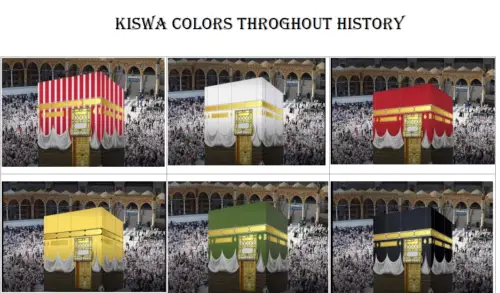
The same cloth remained there until it was accidentally burned in an attempt to fumigate the cloth using incense. Muhammad SAW then began the tradition of annually renewing the Kiswah, which was continued by the caliphs who ruled in his stead.
With the advent of the Ummayyad Caliphate, a new Kiswah replaced the old one twice a year. The first took place in a ceremony on tenth day of Muharram, the first month of the Islamic calendar, and the second on the last day of the holy month of Ramadan, before the Eid Al-Fitr celebrations.
During the Abbasid period, three separate colors were used at different times, until Al-Nasir li-Din Allah, the 34th Abbasid caliph, decided to use only a black Kiswah. This tradition has continued to this day.
In 1927, King Abdulaziz issued a royal order for the construction of factories and villages dedicated to making the Kiswah. Sheikh Abdul Rahman Al-Ansari was the first manager of the factory, and in 1977 he established a new facility for manufacturing the Kiswah, where they are made to this day.While the materials used to be sourced from Egypt and the surrounding countries, the finest silk threads are now imported from Switzerland and Italy. Costing SAR 20 million (USD 5.3 million), the Kiswah is the most expensive cloth in the world. According to Bajouda, this sum of money includes the cost of raw materials, wages for those involved in the construction and administration costs.
Also read- How to Get a Kiswa Factory Appointment
CHANGING OF KISWA AND IT’S DISTRIBUTION
Every year, pieces of the old Kiswa are presented as gifts to Muslim countries and senior Muslim personalities.
Jazak Allah Khair for reading.
Discover more from Islam Hashtag
Subscribe to get the latest posts sent to your email.


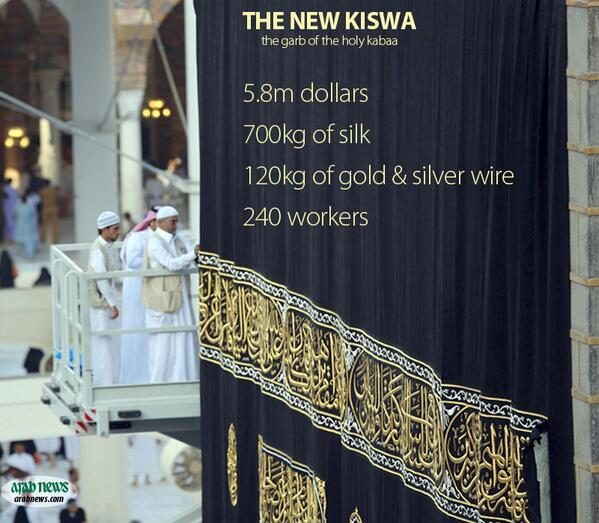
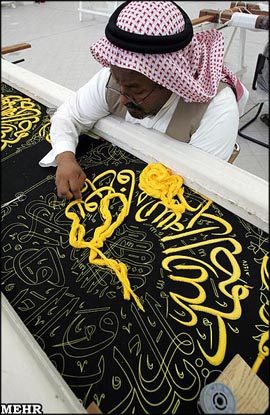
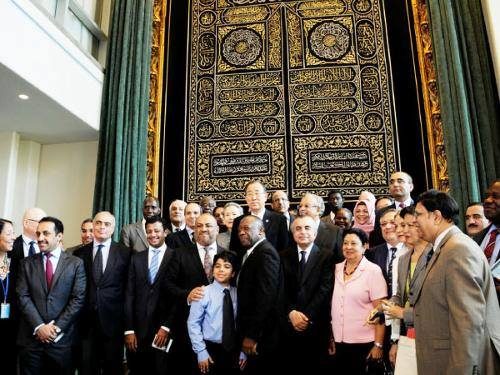

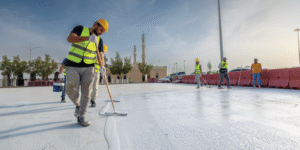


These are the informations every Muslim must know. May Allah bless you for your self less service
Wallahi ,I felt like to cry .i have never benefited on internet wherever in the world like connecting to this site of yours ,May ALLAH make your exams easy.May he bless you with entering FIDDAUS& INSHA ALLAH as far as i am alive this site is my daily companion.
I know the value of knowledge you imparted on me.
i will never get tied of Dua to you.